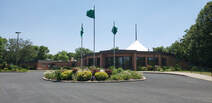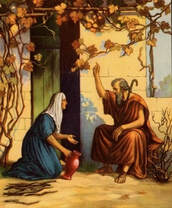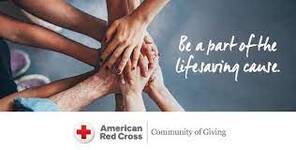 Whether or not it was intentional, our mission statement gets it right, it begins with “We are a welcoming…community.” Most of us think this begins with our greeters, however a Church’s location, its grounds, building, parking lot, and entrance, all come before a person enters our building. We are blessed to be a few blocks away from an interstate and on a very busy street. It is easy to get to our church location and our building is very noticeable. Much thanks to our Yard Care group, parking lot island gardeners. I want to specifically name Marc Dunham, for taking care of our grounds and outside maintenance. Last, but not least, our entrance is superb. The flags call people to our front door entrance. Another person to thank is Larry Nelson for making the front circle garden so beautiful, he was just here this morning taking care of it. A way to thank all who help year round is to give a day of your time this coming weekend. Blue Jeans Weekend – rain or shine April 29th (9:00am) and 30th (after services) There is dead foliage to clean up around the irises, daylilies, and other plants. The weeds are already growing (do they ever stop?) and the mulch can be stirred. The Rain Garden needs several of the grasses and plants cut back. Inside, there are light fixtures with bugs that need to be cleaned out. The walls in the Great Room could stand to be washed, as well as many of the other painted surfaces… What other areas can you identify inside that could use some attention. If you are able to help outside, please bring the tools you are comfortable using as well as gloves. If you are able to help clean inside, please bring a scrub bucket, rubber gloves, rags, step stool or small ladder… I’d like to think we all want St. Luke’s to make that good first impression. Especially on our 100th Anniversary. Hope to see you there! Yes – “A building will never save a soul, and it will never disciple someone.” However – Facilities have a direct impact on the church’s mission. Someone visiting a church for the first time that is not cared for will be asking, “If they can’t take care of their building, how will they take care of me?” A first impression is just that, it will determine whether or not there will be a second one where they can be part of a “… growing faith community, busy making Christ known to the world.”
0 Comments
 “The gifts the Lord gave were that some would be apostles, some prophets, some evangelists, some pastors and teachers, 12to equip the saints for the work of ministry, for building up the body of Christ, 13until all of us come to the unity of the faith and of the knowledge of the Son of God, to maturity, to the measure of the full stature of Christ. Ephesians 4:11-13 During the Easter Season we announce the Risen Lord, Alleluia! Christ is Risen! Christ is Risen, indeed. Alleluia! What God has done through Jesus life, death, and resurrection brings eternal healing as we are faithful, trusting, and prayerful. That is what we hear in the life of Elijah the prophet. What We Can Learn from Elijah? “Even in the face of adversity and discouragement, Elijah remained faithful. Throughout the Bible, he is held up as an example of godliness and might. Not only is he mentioned later in the Old Testament, but also in all four gospels and two epistles. He even appears at the transfiguration with Jesus, and when Jesus began his ministry, some thought that He was Elijah returned to earth. The story of Elijah can be a comfort and an encouragement to us. Being a strong person of God does not mean that we will never feel discouraged, but rather, it means looking to God when faced with adversity. Elijah felt alone, and didn’t understand God’s plan, but he still searched God out. In return, he constantly saw God’s power displayed in his weakness: when He brought the widow’s son back from the dead, when He triumphed on Mt. Carmel, and when He rained down fire from heaven upon the king’s men. For his faithfulness, Elijah was one of the few individuals in the Bible to be taken into heaven.” – Basilica in DC, Blog We are not all called to be a prophet, but our faith does call us to be about the work of God in our time and place. 12To equip the saints for the work of ministry, for building up the body of Christ.” So what are you called to be and do as a follower of Jesus? Whatever it may be, let us do it in the following Paul’s direction he gave to the Ephesians. We are knit together facing adversity by speaking the truth in love… as each part is working properly, promotes the body’s growth in building itself up in love.” This is our calling as members of St. Luke’s to create a mission post, so we and others can share the Good News of Jesus Christ with a world that so desperately needs it. 14We must no longer be children, tossed to and fro and blown about by every wind of doctrine, by people’s trickery, by their craftiness in deceitful scheming. 15But speaking the truth in love, we must grow up in every way into him who is the head, into Christ, 16from whom the whole body, joined and knitted together by every ligament with which it is equipped, as each part is working properly, promotes the body’s growth in building itself up in love.” – Ephesians 4:14-16 Alleluia! Christ is Risen! Christ is Risen, indeed. Alleluia! We are called to serve and we can serve by giving--
In advance of our 100th Anniversary Celebration, St Luke’s will be hosting a Blood Drive on Tuesday, May 2, 2023 from 1:00 pm to 7:00 pm in Fellowship Hall to sign up online for an appointment, visit redcrossblood.org Or call 1-800-RED CROSS (1-800-733-2767). or alternatively to sign up for an appointment or for further information, contact Larry Nelson 612-599-5240 [email protected] Leviticus 17:11 The life of the flesh is in the blood
The history of blood transfusions is an interesting study of myths, traditions and science. The idea of transferring blood to a sick person to restore their health is quite old and was present in ancient myths, including those of Odysseus and Medea. Ancient peoples were certain of the importance of blood but they knew none of its biology. Blood was hidden, visible only in a wound or during childbirth or menstruation. Some ancient Greeks considered blood to the be the same as the soul or spirit. Observant Jews and Muslims followed dietary laws that forbid the consumption of blood and special preparation of meat was required. These measures also had added health benefits helping to prevent the spoilage of meat. As Christians we connect blood with spiritual life through communion. Today we know red blood cells carry life giving oxygen to the cells of our body and white blood cells defend us from invasion by foreign pathogens. Platelets help form clots that can prevent bleeding. Blood is constantly being produced by stem cells in our bone marrow. Our network of veins, arteries, and capillaries is about 60 thousand miles long. Blood plasma is a combination of salt and water similar in concentration to water in the sea. The possibility of successful blood transfusions required significant scientific advances. In 1628 British physician William Harvey discovered the circulation of blood, exploring the relationship between arteries, veins and capillaries. In 1658 microscopist Jan Swammerdam observed and described red blood cells. Soon afterward people became interested in the possibility of blood transfusions. The first recorded successful blood transfusion was performed in England in 1665 by Physician Richard Lower keeping a dog alive by transfusing blood from another dog. In 1667 successful transfusions were reported from sheep to humans but successive efforts were not successful. It wasn’t until 1818 that the first successful human to human blood transfusion was performed by British obstetrician James Blundell to a patient for the treatment of postpartum hemorrhage. The blood donor was the husband of the donor. It was fortuitous that this choice was successful (he might have been a universal donor). Successive transfusions were not as successful, however, since not all blood from donors was compatible to the patient. In 1901, Austrian physician Karl Landsteiner discovered the first human blood groups. Soon after all four blood groups were identified and the interactions between them determined whether a transfusion would be safe. in 1907 Ludwig Hekoen proposed that blood transfusion would be more successful if the blood of the donor and patient were cross matched to exclude incompatible mixtures. This was followed shortly by the first blood transfusion using blood typing and cross matching. It was soon discovered that blood group O is a universal donor. In 1916 the first blood transfusion was performed with stored and refrigerated blood. Another significant discovery occurred in 1937 when the Rh factor explained blood incompatibilities between certain mothers and fetuses, at that time a leading cause of stillbirths. Today blood can be stored and separated into red cells, platelets and plasma. Plasma can be further processed to treat many health conditions including hepatitis, chickenpox, protein deficiency and hemophilia. Truly, blood donation is the gift of life! Larry Nelson Blood Drive Coordinator |
Archives
July 2024
Categories |
